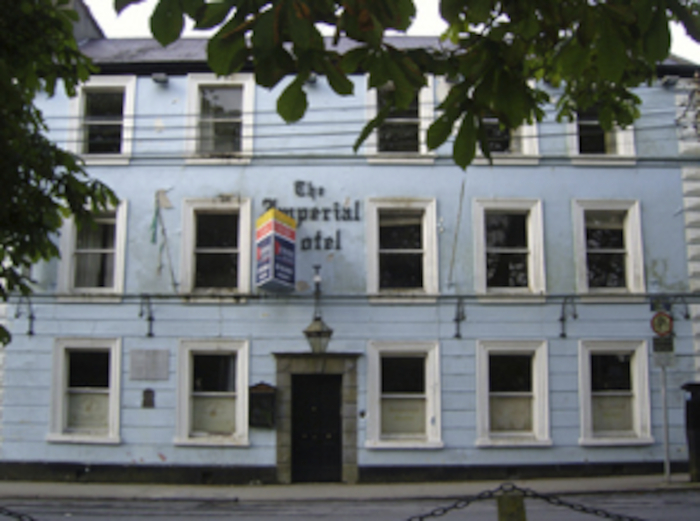In November 1842, Castlebar businessman Martian Sheridan was declared bankrupt. Dublin auctioneer John Littledale published a list of Sheridan's assets to be sold by public auction.
Among Sheridan's vast property portfolio in Castlebar was a hotel and associated houses, out-offices, yard, stables, coach-house, and garden. The hotel was known as Sheridan's Hotel, and the hotel's long rooms as 'Sheridan's Great Rooms.' Today we know it as The Imperial Hotel or Daly's Hotel.
Built in 1795, the hotel was initially two separate three-bay, three-story townhouses. From the early nineteenth century, the mail coach stopped at the hotel. The building was reconstructed between 1891 and 1892 to take its present form. It has been vacant since 2009.
In August 1798, the hotel witnessed the closing skirmishes of the most celebrated military victory in the history of Mayo – the Battle of Castlebar. Spectators likely watched from the windows of the hotel. Weeks later, those at the hotel had a ringside seat at the hanging of Father Conroy and other rebels from the hanging tree on the Green in front of the hotel.
The hotel's long association with the court services began in December 1806 when a special commission court opened at the new courthouse on the Green as part of a government-led initiative to suppress a secret society known as the Threshers. Many lawyers, judges, and civil servants who arrived in Castlebar in coaches protected by dragoons stayed at the hotel. Following the trials, crowds gathered to witness six hangings on gallows close to the hotel.
In the 1830s and 1840s, the hotel was the Mayo home of the Repeal Movement and meetings were frequently held on the premises. In 1836, the election of repeal candidate Robert Dillon Browne was celebrated at the hotel. On 23 January 1837, Sir William Brabazon MP and other friends of Daniel O'Connell entertained the Liberator in the Great Rooms. On 26 July 1840, a dinner was held in the rooms in honour of O'Connell after a repeal demonstration. The 150 guests listened intently to O'Connell's speech. On 31 July 1843, the Liberator was back in the Great Rooms following another demonstration. Three hundred guests, including O'Connell's son, cheered and toasted O'Connell following his lengthy address.
Bankruptcy notwithstanding, Martin Sheridan managed to retain an interest in the hotel. In 1854, he was again declared bankrupt, and the hotel was offered for sale. Three houses and stables were excluded from the deal as they had been sold in the Encumbered Estates Court. At this time, James Armstrong occupied the hotel as a tenant at will.
In 1856, John Daly purchased the hotel but sold it in 1860 to Elizabeth Murtagh. Legal proceedings between Murtagh and Bank of Ireland in 1888 show that she continued to trade under the name Daly's Hotel.
In 1870, the hotel hosted a gathering to review the bill that would become the Land Act 1870. In August 1874, James Daly chaired a meeting of supporters of John O'Connor Power MP at the hotel. The foundation of the Land League at the hotel by Davitt, Daly, and Parnell in 1879 gave the hotel its historical pedigree. In August 1880, Davitt and O'Connor Power met in the hotel to agree on a strategy for the 1880 General Election.
Throughout its history, the hotel was one of the principal locations for social gatherings in Castlebar. Many political, benevolent, and social societies used it as their base. Concerts, military, debutante, and post-race meeting balls were frequently held in the Great Rooms. In the twentieth century, the hotel was the backdrop for large political rallies on the Green. In April 1922, Michael Collins fled the speaker's platform outside the hotel and took refuge in the foyer with his sister Kitty when anti-treaty elements appeared.
The building that was the Imperial Hotel is of national historical importance. Davitt, Parnell, O'Connell, O'Connor Power, and other social reformers and political heavyweights of the nineteenth century all walked the corridors of the hotel when they were writing the script for a better Ireland. The hotel is part of the story of Ireland and the essential fabric of Castlebar. Preservation of the building through sympathetic repurposing is vital. (Photograph: www.buildingsofireland.ie ).

